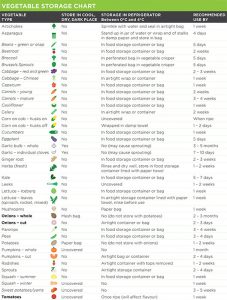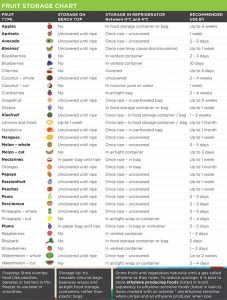Research
 CERES Fair Food have published a guide for storing your fruit and vegetables. It comes in two forms:
CERES Fair Food have published a guide for storing your fruit and vegetables. It comes in two forms:
- An overall graphic (see right and/or download their original pdf).
- A page with a paragraph about how to store each fruit and vegetable. (posted February 21 2024)
Open Food Network Australia and Fair Share Fare recently undertook a project to explore land management options for ageing landowners in Nillumbik. Read their final report. (posted March 1 2023)
The Foodprint Melbourne research project began in 2015. Its 3rd phase – Building the resilience of Melbourne’s food system – has just finished and its 4th phase – Victorian food resilience planning project – is just starting. The main report from the 3rd phase was entitled Building the resilience of Melbourne’s food system – a roadmap. Read/download the full report (82 pages). Read/download a summary briefing (8 pages). (posted October 26 2022)
I recently came across these handy food storage charts produced by Moreland Council. The left hand chart is for vegetables and the right hand one is for fruit. Jpg images are never really good enough quality for printing purposes. If you want to print off the charts, use this high resolution pdf version. (posted June 1 2022)
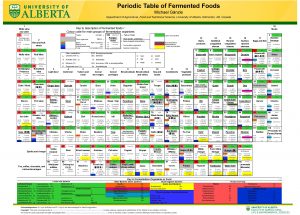 The picture right is of a periodic table of fermented foods. Click the picture, and then zoom, for a readable, high resolution version. Open this pdf for an even higher resolution version.
The picture right is of a periodic table of fermented foods. Click the picture, and then zoom, for a readable, high resolution version. Open this pdf for an even higher resolution version.
For each of 118 fermented foods, the picture sets out the origin of the food, the main ingredients, typical fermentation organisms, pH, water activity, fermentation/ripening time, and the major microbial metabolites that relate to product quality. The contribution of major groups of fermentation organisms is colour coded as indicated in the legend; back-slopped fermentations are indicated by a thick outline and by an underlined product name. (posted May 11 2022)
Read this report, entitled Re-thinking food and agriculture. To give you a flavour, here is the very first sentence: “We are on the cusp of the fastest, deepest, most consequential disruption of agriculture in history.” Note that you can read the summary online but you have to enter your name and email address to get the full report. (posted February 2 2022)
Darebin Council have published a free, downloadable seed saving guide (pdf). (posted September 1 2021)
Farmer Incubator and Young Farmers Connect have just released a report entitled Regeneration – Growing New Farmers. The report discusses the challenges that new and young farmers face getting started as they attempt to farm regeneratively, address food and land justice, gain entry into the value chain and become viable. Read or download the report. (posted March 10 2021)
Did you know that Australians:
- Use 50,000 coffee cups every half hour.
- Use over 10 million plastic bags every day.
- Buy 1 billion plastic water bottles every year.
- Throw away 3.5 billion plastic straws every year.
Take the Plastic Free July challenge to choose to refuse single-use plastics during July to avoid landfill waste, reduce your eco-footprint and protect the oceans. (posted June 26 2019)
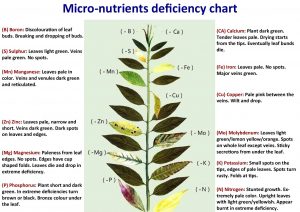 Micro-nutrients: The picture right is a useful summary of what leaves can look like when particular micro-nutrients are lacking. Plus it is A4 shape so you can print it off and stick it on your wall. Thanks to Greta Gillies for pointing out the original material. (posted January 2 2019)
Micro-nutrients: The picture right is a useful summary of what leaves can look like when particular micro-nutrients are lacking. Plus it is A4 shape so you can print it off and stick it on your wall. Thanks to Greta Gillies for pointing out the original material. (posted January 2 2019)
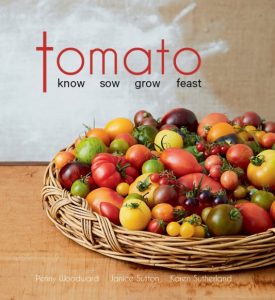 Tomato: know, sow, grow, feast is a new book about Australian heirloom tomatoes. One of its authors is newsletter reader Karen Sutherland, with the others being Penny Woodward and Janice Sutton. Here is what the back cover says: “Heirloom, organic, Australian. Karen leads you through organic heirloom tomato growing, from seed sowing to feeding, pruning and training. She outlines a variety of ways to grow, tells stories of some passionate growers, and helps you to keep problems at bay with an extensive illustrated pest and disease section. Penny chronicles the history of heirloom tomato varieties in Australia and explains how to breed your own heirloom tomatoes. She also details why tomatoes are so good for you, and why a red tomato is red! Finally Penny lists, and describes in detail, more than 220 different heirloom tomatoes that can be sourced in Australia today. Janice explores the enticing and diverse range of heirloom tomato flavours, describes in detail how to select, prepare and cook heirloom tomatoes, and explains how to create the perfect tomato passata and paste. Finally, she shares more than 60 delectable tomato recipes from renowned chefs from all over Australia.” Booktopia says: “What [sets the book apart] is the extensive list and descriptions of heirloom tomato pests and diseases, painstakingly researched by gardening expert Karen Sutherland, that includes an indispensable pest and disease chart to help gardeners identify and control them.” (posted September 19 2018)
Tomato: know, sow, grow, feast is a new book about Australian heirloom tomatoes. One of its authors is newsletter reader Karen Sutherland, with the others being Penny Woodward and Janice Sutton. Here is what the back cover says: “Heirloom, organic, Australian. Karen leads you through organic heirloom tomato growing, from seed sowing to feeding, pruning and training. She outlines a variety of ways to grow, tells stories of some passionate growers, and helps you to keep problems at bay with an extensive illustrated pest and disease section. Penny chronicles the history of heirloom tomato varieties in Australia and explains how to breed your own heirloom tomatoes. She also details why tomatoes are so good for you, and why a red tomato is red! Finally Penny lists, and describes in detail, more than 220 different heirloom tomatoes that can be sourced in Australia today. Janice explores the enticing and diverse range of heirloom tomato flavours, describes in detail how to select, prepare and cook heirloom tomatoes, and explains how to create the perfect tomato passata and paste. Finally, she shares more than 60 delectable tomato recipes from renowned chefs from all over Australia.” Booktopia says: “What [sets the book apart] is the extensive list and descriptions of heirloom tomato pests and diseases, painstakingly researched by gardening expert Karen Sutherland, that includes an indispensable pest and disease chart to help gardeners identify and control them.” (posted September 19 2018)
Karen Sutherland has written in: “I thought you’d like to know that Booktopia and similar online sites discount books so much that authors usually (us included) make a loss for every book sold there. We self-published, and so are trying to encourage people to buy from us directly [here is the relevant page from Karen’s online shop] or from a supplier such as Bulleen Art & Garden, CERES or Bee Sustainable. I had no idea until I wrote this book, and often bought from these sites.” (posted September 19 2018)
Sustainable Gardening Australia have published a summary of the book. (posted December 5 2018)
Talking about people who have written books – here’s something that you don’t know (and probably don’t want to know): I (Guy Palmer) am an erstwhile book author and you can still buy some of my books online at Amazon. For example, my 2006 book on housing and my 2002 book on poverty & social exclusion. (posted September 19 2018)
See a science experiment on soil erosion, which demonstrates the relationship between precipitation, soil erosion, protection of watercourses and vegetation. (posted November 29 2017)
Are you eating genetically modified food?: Choice has published a straightforward summary of the genetically modified products currently available, or in development, in Australia. (posted December 7 2016)
International food days: I got two emails this week about international food days, one about the lack of local events celebrating International Coffee Day (1st October) and the other about an upcoming event celebrating World Vegan Day (23rd October). That got me thinking: what other ‘official food days’ are there?
I soon discovered National Chocolate Day (7th July), where I sadly missed all the events that happened in the CBD. I then discovered that, although World Vegan Day is on 23rd October this year in Melbourne, it is usually on the last Sunday of October and, in the rest of the world (including Adelaide), it is on 1st November (apparently to coincide with the Day of the Dead).
In any event (sic), to make sure that you can plan your celebratory events for next year, here are some of the ‘official food days’ that have at least some profile in Australia:
- March 22nd: World Water Day.
- 47 days before Easter: Pancake Day.
- May 13th: International Hummus Day.
- June 1st: World Milk Day.
- June 18th: International Sushi Day.
- May 6th: International No Diet Day.
- May 28th: National Hunger Day.
- May 28th: National Burger Day.
- May (3rd Sunday): World Baking Day.
- July 7th: World Chocolate Day.
- July 21st: International Lamington Day.
- August (1st Friday): International Beer Day.
- October 1st: International Coffee Day.
- October 1st: World Vegetarian Day.
- October 2nd: World Farm Animals Day.
- October 16th: World Food Day.
- October 25th: World Pasta Day.
- October (2nd Friday): World Egg Day.
- November 1st: World Vegan Day (but see the discussion above).
Note we have all just missed International Talk like a Pirate Day (19th September). Apparently, on that day one can choose ‘pirate’ as the language in a Google search! And it is a holiday for members of the Church of the Flying Spaghetti Monster (aka the Pastafarians) who, inter alia, assert that a decline in the number of pirates over the years is the cause of global warming. (posted October 5 2016)
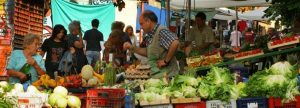 Our Italian correspondent reports: the Slow Food movement was founded in Italy 30 years ago by Carlo Petrini in response to the arrival of McDonalds in Rome. It now manifests throughout Italy. ‘Terra Madre Mercati’ (Mother Earth Markets), of which there are now 55, mostly in Italy, are part of the movement. One of them takes place every Saturday morning in Umbertide. It is confined to growers and producers from within forty kilometres of the town. As well as fruit and vegetables, cheese, bread, cakes, jams, honey, olive oil and pottery are also available. Many of the participants are committed to totally organic produce, although this is not mandatory. One participant is a baker making bread with milled hemp seeds. Another is a fruit and veggie stall with connections to ‘Fondazione Amica Campagna’ (Foundation for the Countryside), a foundation that cooperates with participants from all branches of the food industry that support ideals such as seasonality, low food mileage, and a culture of conscious spending. (posted August 17 2016)
Our Italian correspondent reports: the Slow Food movement was founded in Italy 30 years ago by Carlo Petrini in response to the arrival of McDonalds in Rome. It now manifests throughout Italy. ‘Terra Madre Mercati’ (Mother Earth Markets), of which there are now 55, mostly in Italy, are part of the movement. One of them takes place every Saturday morning in Umbertide. It is confined to growers and producers from within forty kilometres of the town. As well as fruit and vegetables, cheese, bread, cakes, jams, honey, olive oil and pottery are also available. Many of the participants are committed to totally organic produce, although this is not mandatory. One participant is a baker making bread with milled hemp seeds. Another is a fruit and veggie stall with connections to ‘Fondazione Amica Campagna’ (Foundation for the Countryside), a foundation that cooperates with participants from all branches of the food industry that support ideals such as seasonality, low food mileage, and a culture of conscious spending. (posted August 17 2016)
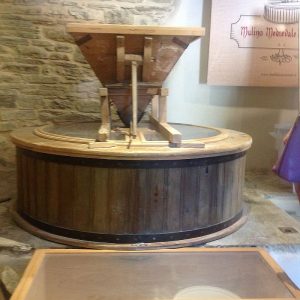 In Umbertide, there is a flour mill which dates back around 800 years. Its design is based on mills used in Greece and Turkey and was introduced to Italy in the Middle Ages when laws forbidding slavery were introduced and water-powered mills replaced those operated by slaves. The mill is still powered by water diverted from the local river and produces exclusively organic wholemeal flour from locally-grown heritage wheat varieties. Inter alia, they are milling heritage red romanino corn, whose flour is apparently the best for making polenta. (posted August 24 2016)
In Umbertide, there is a flour mill which dates back around 800 years. Its design is based on mills used in Greece and Turkey and was introduced to Italy in the Middle Ages when laws forbidding slavery were introduced and water-powered mills replaced those operated by slaves. The mill is still powered by water diverted from the local river and produces exclusively organic wholemeal flour from locally-grown heritage wheat varieties. Inter alia, they are milling heritage red romanino corn, whose flour is apparently the best for making polenta. (posted August 24 2016)
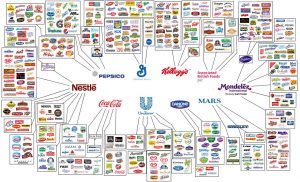 Which brands do the big food and beverage companies own? This graphic shows which brands the big food and beverage companies own. The graphic is from a 2013 Oxfam briefing paper entitled Behind the brands: food justice and the ‘big 10’ food and beverage companies. In support of this paper, Oxfam has also set up a behind the brands website which, inter alia, allows you to select a brand and see how it rates against a variety of criteria. (posted July 27 2016)
Which brands do the big food and beverage companies own? This graphic shows which brands the big food and beverage companies own. The graphic is from a 2013 Oxfam briefing paper entitled Behind the brands: food justice and the ‘big 10’ food and beverage companies. In support of this paper, Oxfam has also set up a behind the brands website which, inter alia, allows you to select a brand and see how it rates against a variety of criteria. (posted July 27 2016)
Our Canadian correspondent reports: I just wanted to tell you all about the fantastic waste management system here. It is the law that everyone sorts their garbage and places it in the correct bins. Random inspections are made and people are fined for incorrect sorting. Interestingly, every household is provided with a bench bin for food scraps and a larger outside bin to empty this in to. When collected, the food scraps are turned into compost and residents can pick this up free. There is also a recycle bin (with clear instructions of what materials can be recycled) and another bin for non recyclable/non compostable garbage. There does not seem to be a bin for garden waste. (posted July 20 2016)
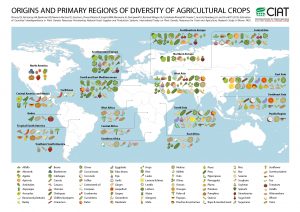 The origin of crops: have a look at this interactive map of the origin of crops. Or have a look at the non-interactive graphic on the right. The original version did not include the all-important macadamia nut(!), but thankfully this has been included in the interactive version. (posted June 22 2016)
The origin of crops: have a look at this interactive map of the origin of crops. Or have a look at the non-interactive graphic on the right. The original version did not include the all-important macadamia nut(!), but thankfully this has been included in the interactive version. (posted June 22 2016)
Is this a good rule?: “Vegetables that grow underground – start off in cold water; vegetables that grow over ground – place in boiling water.“
It comes from the Farmers’ Almanac Facebook. Here is their rationale:
- Cooking corn, peas, etc. simply entails softening their cell walls to make them more palatable and easier to digest. Because most green vegetables are small and/or thin, this does not take long. So you add those to boiling water.
- Root vegetables contain a great deal of starch, which needs to be dissolved before they can be eaten. It takes a while for the heat to penetrate the vegetables. Starting root vegetables out in cold water, and heating the outside layers, gradually allows the cell walls get reinforced and become more resistant to the effects of overcooking. This works especially well on starchy root veggies, like potatoes, since the gradual temperature change keeps the outer edges from overcooking and turning mealy.
I tried Googling to see whether others agreed with the rule. I found a number of sites in support. I also found some that said one should always steam rather than boil (to lessen vitamin leaching), and a few that advocated adding things to the water (e.g. fat and citrus, as well as salt). (posted April 27 2016)
Recipes, definite and indefinite articles: something that has been bugging me for ages – why do recipes rarely contain the words “the” or “a” (at least until I get my hands on them)? Is it some sort of rule? Who decided? (posted April 27 2016)
‘Free range’ egg producers that you should avoid: as many of you will know, the state, territory and federal consumer affairs ministers met on 31st March and decided that ‘free-range’ can mean eggs produced by hens stocked at up to 10,000 birds per hectare, not the maximum 1,500 per hectare that the CSIRO Model Code recommends. Choice, who have been running a campaign on this issue, have put together a list of egg producers who you should avoid because, although they call themselves ‘free range’, their stocking densities are 10,000 birds per hectare:
- Aldi Lodge Farm Free-Range Eggs.
- Coles Free-Range Eggs.
- Eco Eggs.
- Farm Pride Free Range Eggs.
- Manning Valley Free-Range Eggs.
- Meggles Farm Free-Range Eggs.
- Misty Mountain Free Range Eggs.
- Otway Free Range Eggs.
- Pace Farm Free-Range Eggs.
- Pace Omega 3 Free-Range Eggs.
- South Gippsland Eggs Free-Range.
- Woolworths Select Free-Range Eggs. (posted April 6 2016)
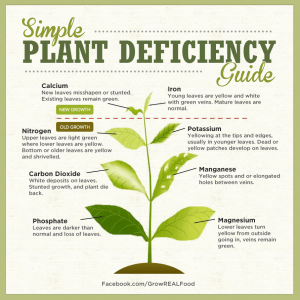 Identifying plant deficiences: a useful graphic and article from the Grow Real Food website. (posted October 28 2015)
Identifying plant deficiences: a useful graphic and article from the Grow Real Food website. (posted October 28 2015)
Another useful table and short article (pdf) on the same subject. (posted October 28 2015)
The long term costs of organic compared to intensive farming: an in-depth article which uses life cycle analysis on organically farmed tomatoes and pears, and intensively farmed wheat, apples and lettuce to show the overall impact of agricultural methods. Click here to read the full article or click here to read a one page introduction. (posted July 1 2015)
Genuine free range: Whereas some parts of the world (e.g. the European Union) regulate marketing standards for egg farming, and thus what can be described as ‘free range’, Australia does not. Rather, the theory in Australia is apparently “The producer is bound by consumer expectations and perceptions of what constitutes free range. Producers are generally thought to be bound to Model Codes of Practice of Animal Welfare: Domestic Poultry published by the CSIRO.” (see Wikipedia).
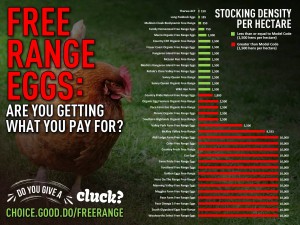 The (hardly unexpected!) problem is that, in practice, many producers do not feel themselves bound by the CSIRO code and the public is none the wiser. This is clear from the graphic (click it for a full size version): whereas the CSIRO code specifies an upper limit of 1,500 chickens per hectare, many of the major ‘free range’ egg producers have up to 10,000 chickens per hectare. To find out more about this issue, read CHOICE’s recent report or their
The (hardly unexpected!) problem is that, in practice, many producers do not feel themselves bound by the CSIRO code and the public is none the wiser. This is clear from the graphic (click it for a full size version): whereas the CSIRO code specifies an upper limit of 1,500 chickens per hectare, many of the major ‘free range’ egg producers have up to 10,000 chickens per hectare. To find out more about this issue, read CHOICE’s recent report or their
associated Facebook post. Thanks to Wendy Moore for pointing out these links to me.
It may well be that proper regulation will be introduced in the new year (e.g. see recent news reported by the ABC). But in the meantime what can you do about the situation? The obvious solution is to buy your eggs from a producer who is actually certified against some actual, defined standards. There are two such standards: Free Range Farmers Association in Victoria (maximum 750 chickens per hectare) and Humane Choice (maximum 1,500 chickens per hectare). There are a total of 11 egg producers in Victoria who have one of these two certifications. And one of these – Top Hundred Acres from Yan Yean – is local to us and has several local outlets, including Eltham Farmers’ Market. The eggs of one other (Family Homestead Genuine Free Range Eggs) are apparently available from Coles. (posted June 17 2015)
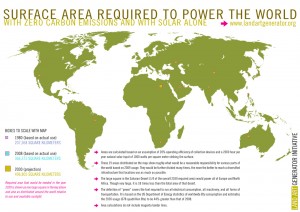 Not food, but interesting: I usually keep the material in this newsletter strictly to matters food. But this graphic by The Land Art Generator Initiative of the total surface area required to fuel the world with solar power is just too interesting to omit. The article in which the graphic was first shown is equally interesting. It is so refreshing to read analysis rather than polemic. (posted May 20 2015)
Not food, but interesting: I usually keep the material in this newsletter strictly to matters food. But this graphic by The Land Art Generator Initiative of the total surface area required to fuel the world with solar power is just too interesting to omit. The article in which the graphic was first shown is equally interesting. It is so refreshing to read analysis rather than polemic. (posted May 20 2015)
Where Australia’s imported food comes from: an interesting, interactive graphic. (posted March 4 2015)
Disappearing bees: This is a well told story, 15 min TED talk. (posted May 1 2014)
Urban food production in Melbourne: A study has been done showing that home food production is thriving. Even though we know it, it is good to have some evidence! (posted February 20 2014)
Reducing food loss and waste: A working paper, from The World Resources Institute (WRI) and the United Nations Environment Program (UNEP), shows that more than half of the food lost and wasted in Europe, the United States, Canada, and Australia occurs close to the fork, at the consumption stage. By contrast, in developing countries, about two-thirds of the food lost and wasted occurs close to the farm, after harvest and storage. (posted June 13 2013)

